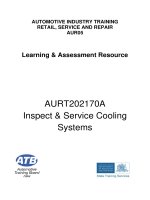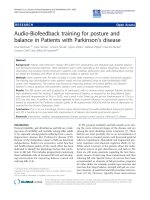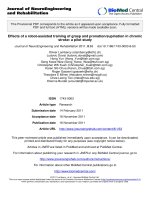Toyota training diagnostic techiques and tools
Bạn đang xem bản rút gọn của tài liệu. Xem và tải ngay bản đầy đủ của tài liệu tại đây (1.62 MB, 18 trang )
Technician Handbook
673 Electronic & Computer Controlled Systems
Section 1 Topics
Electronic Control Units
Technical Training
• Electronic Control Units
• Logic Function
• Simple ECU Inputs
• Simple ECU Outputs
• Self-Diagnosis
• Memory
• Customization
• Initialization
5
Technician Handbook
673 Electronic & Computer Controlled Systems
Electronic Control Units
Electronic Control Units
(ECUs) are small
computers programmed to
perform specific
automotive functions.
What are some typical
automotive ECUs?
ECUs use electronic components in
integrated circuits to perform their functions.
Electronic
Control Units
In the 1970’s, the decreasing cost and increasing power of computerized
microprocessors launched the personal computer industry. Because of their
speed and flexibility in carrying out complex functions, microprocessors were
adapted for hundreds of uses beyond personal computers.
The first microprocessors began appearing in automotive engine control
systems in the early 1980s. In automotive applications, they became known
as electronic control units (ECUs). Today, some vehicles may have
dozens of ECUs controlling a wide variety of vehicle systems, including:
• engine controls
• transmission
• braking
• steering
• air conditioning
• door locks
• suspension
• cruise control
• tire pressure monitoring
• and many other systems.
6
Technical Training
Technician Handbook
673 Electronic & Computer Controlled Systems
ECU Logic Function
ECUs have electronic logic circuits that “make decisions”
by evaluating conditions according to predetermined rules.
Light Control SW
Headlights
Light Control
Sensor
Body ECU
How ECUs
Work
Conditions
IF
Light control switch is in the AUTO position
and
Light control sensor detects LOW ambient light
and
Ignition switch is ON
Decision
Taillights
THEN
Turn headlights ON
Turn taillights ON
An ECU is a small computer programmed to perform a specialized function in
the vehicle. As with any computer, it operates on the principle of input,
processing, and output.
Input – Information about conditions is supplied to the ECU as input signals.
Input can be provided by:
• sensors
• switches
• other ECUs.
Processing – The ECU analyzes the input signals. Based on its
programming, it determines what output signals to send, if any.
Output – Vehicle systems are controlled by the ECU output signals. These
signals may cause a motor to operate, a light to come on, or some other
operation of a vehicle component.
Logic Function
For an example of the ECU’s logic function, consider the lighting control
system which is within the Body ECU. A simple lighting control system uses
three inputs – the light control switch, the light control sensor, and the ignition
switch.
When the condition of these three inputs matches the conditions
preprogrammed in the ECU, the ECU turns on the headlights and taillights.
Technical Training
7
Technician Handbook
673 Electronic & Computer Controlled Systems
Simple ECU Inputs
Voltage ON/OFF
Voltage Pulse Pattern
Combination
Switch
Active
Speed
Sensor
MRE A
MRE B
Sensor IC
Variable Voltage
Variable Resistance
What are some other
types or examples of
ECU inputs?
Oxygen
Sensor
Temp
Sensor
Exhaust Gas
Simple ECU
Inputs
Signals from switches and sensors can supply information to the ECU in
several ways.
Voltage ON/OFF – A simple switch opens or closes a circuit. It is the
presence or absence of voltage in the circuit that signals the ECU.
Variable Voltage – Some sensors produce a voltage that changes
depending on the conditions the sensor is measuring. The amount of voltage
produced at any given moment provides information about the condition at
that time.
Variable Resistance – In other types of sensors, electrical resistance
increases or decreases as external conditions change. Sensing the changing
voltage as a result of changing resistance in the circuit signals the ECU what
the conditions are.
Variable Pulse Pattern – Another method for signaling the ECU about
changing conditions is to turn a circuit on and off rapidly at a particular
frequency. This works especially well for signaling rotational speed. It is the
frequency of the ON/OFF pulses that supplies information to the ECU.
8
Technical Training
Technician Handbook
673 Electronic & Computer Controlled Systems
Voltage ON/OFF (Switch) Input
The ECU detects the state of a ground-side switch by reading the
circuit voltage.
When switch ON is detected, the ECU performs a function, such as turning on a lamp.
B+
B+
OFF: V = 12.6V
(open circuit voltage)
0V
ECU
12.6V
Ground-side
switched
12.6v
ON: V = 0.1V
(available voltage)
*
5V
ECU
12.6V
0.1v
*
Voltage can also be measured
at the ECU terminal.
* Conceptual illustration only
Voltage ON/OFF
(Switch) Input
The diagrams above illustrate a ground-side switch connected to an ECU.
The ECU supplies battery voltage to the switch circuit and provides the
circuit’s load (a resistor). The ECU’s electronic circuits detect when the
voltage after the load is high (near battery voltage) or low (near ground
voltage).
While the switch is open, no current is flowing and the available voltage after
the load is near battery voltage. When the switch is closed, current flows and
most of the battery voltage is dropped across the load. The available voltage
after the load is now near ground voltage.
In this example, the switch controls a lamp, but is not actually part of the lamp
circuit. When the ECU senses a voltage drop in the switch circuit, it supplies
five volts to the transistor. This in turn closes the lamp circuit, lighting the
lamp.
SERVICE TIP
NOTE
Technical Training
You can detect the same high or low voltage the ECU is detecting by
measuring voltage at the appropriate ECU terminal. If the switch is closed
and the voltage remains high, you’ll know there is an open in the circuit
between the ECU and the switch.
The actual wiring inside the ECU is extremely complex. The ECU circuit
details shown in the diagrams above and the diagrams on the following
pages are to illustrate concepts, not actual internal connections.
9
Technician Handbook
673 Electronic & Computer Controlled Systems
Variable Voltage Input
The oxygen sensor is a voltage generator.
The engine control module
interprets the voltage to make
corrections to the air-fuel ratio.
Voltage
V
Atmosphere
ECM
V > 0.45v : air-fuel ratio too rich
V = 0.45v : air-fuel ratio correct
V < 0.45v : air-fuel ratio too lean
Exhaust Gas
Variable Voltage
Input
An oxygen sensor is a voltage generator, producing between 0.1v and 0.9v
depending on the oxygen content of the exhaust gas compared to the
atmosphere.
The engine control module’s electronic circuits measure the amount of
voltage generated by the oxygen sensor, and use that information to control
the air-fuel ratio.
10
Technical Training
Technician Handbook
673 Electronic & Computer Controlled Systems
Variable Resistance Input
A temperature sensor is a type of variable resistor.
Its resistance changes with temperature.
12.6V or 5V
V
An ECU can detect the change
in the sensor’s resistance by
measuring voltage.
ECU
Variable
Resistance Input
A temperature sensor is a type of variable resistor whose resistance changes
with temperature. This type of sensor is often called a thermistor.
Two types of thermistor are:
Positive temperature coefficient (PTC) thermistor – resistance increases
as temperature increases
Negative temperature coefficient (NTC) thermistor – resistance
decreases as temperature increases
Thermistors are commonly used for engine coolant temperature sensors and
ambient temperature sensors. Modern Toyota vehicles use NTC thermistors
exclusively.
Technical Training
11
Technician Handbook
673 Electronic & Computer Controlled Systems
Pulse Pattern Input
An active wheel speed sensor
generates a series of voltage pulses
as the wheel rotates.
MRE A
MRE B
Sensor IC
As rotation speed increases, pulses
are generated at a higher frequency.
The ECU measures the pulse frequency
to calculate vehicle speed.
Voltage
Voltage
Lower Rotation Speed
Time
Pulse Pattern
Input
Higher Rotation Speed
Time
Another type of ECU input is a pulse pattern. When voltage rises
momentarily, then falls, the transient voltage reading is called a pulse. When
a component creates multiple pulses, the result is a pulse pattern (or pulse
train).
An active wheel speed sensor is a component that generates a pulse pattern.
A magnetic ring mounted on the wheel hub has alternating north-south fields
that are detected by the sensor pickup. As the wheel rotates, the alternating
magnetic fields are converted into a series of voltage pulses. The frequency
of the pulses increases with the wheel rotation speed.
When the pulse pattern is provided as ECU input, the ECU’s circuits are able
to measure the pulse frequency and calculate wheel RPM and vehicle
speed.
12
Technical Training
Technician Handbook
673 Electronic & Computer Controlled Systems
Simple ECU Outputs
When the operating conditions are met, the ECU makes a
connection to power or ground to energize a circuit
ECU
NPN
B+
How a Transistor Works (NPN)
Transistor
5V
Ground-side controlled circuit
ECU
B+
Collector
When voltage
is applied to
the base…
...current can
flow from the
collector to
the emitter
Base
PNP
Emitter
Power-side controlled circuit
A
See Appendix
for More Info
Simple ECU
Outputs
The simplest way for an ECU to control a vehicle function is to turn a circuit
on or off. A circuit can be ground-side switched or power-side switched.
Transistors as
Switches
Electronic circuits use transistors for switching circuits on and off. A
transistor is a solid-state electronic component having a base, collector and
emitter. In the more commonly used NPN transistor, when sufficient voltage
is applied to the base, current flows from the collector to the emitter.
One of the advantages of the transistor is that a low voltage at the base is
able to control a large current flowing through the collector and emitter. In that
respect, a transistor is similar to a relay.
Some transistors also regulate current flow based on the amount of voltage
applied to the base. Within the transistor’s limits, a higher base voltage
results in a greater flow of current through the collector/emitter. This feature
is used in amplifier circuits where the low voltage signal from a microphone
regulates current flow in higher power speaker circuits
Technical Training
13
Technician Handbook
673 Electronic & Computer Controlled Systems
Pulse Width Modulation
The ECU can open and close a circuit rapidly to control
component operation.
The process of varying the amount of time a circuit is ON is called pulse width
modulation.
Example
Voltage
Pulses
The ECM regulates the injector
ON time by regulating the width of
the voltage pulse to the injectors.
Pulse
Width
Notice the pulse width increases at
higher load as the ECM increases
the injector ON time.
Pulse Width
Modulation
An ECU’s electronic circuits have the ability to open and close a circuit very
rapidly. The ECU can switch a circuit on for a fraction of a second at very
precise intervals.
When a circuit is switched ON and then OFF, the momentary change in voltage
creates a voltage pulse. (The pulse can be either a momentary increase or
decrease in voltage depending on whether the circuit is ground-side switched
or power-side switched and where the voltage is measured.)
When the voltage is viewed on an oscilloscope, the voltage pulse’s width
represents the amount of time the circuit is switched ON and can be as brief as
1 millisecond or less. In some circuits, the ECU uses the amount of ON time to
regulate component operation.
When the ECU varies the width of the voltage pulse (the ON time) to control a
component, the process is called pulse-width modulation.
NOTE
14
In the above example, the frequency of the pulses changes as well as the
pulse width. In some circuits, the frequency of the pulses is constant.
Technical Training
Technician Handbook
673 Electronic & Computer Controlled Systems
Measuring Duty Cycle
When the ECU modulates a circuit at a constant frequency, you can measure
the circuit’s duty cycle. Duty cycle is the percentage of ON time compared to
total cycle time.
Varying the duty cycle can
vary the brightness of a lamp
or the speed of a motor.
ECU
B+
If the percentage of ON
time decreases, the
lamp becomes dimmer.
5V
12 V
12 V
0V
0V
1 cycle
(100%)
75% ON (grounded)
1 cycle
(100%)
25% ON (grounded)
In a ground-side
controlled circuit,
measure after the load.
Duty Cycle
The terms pulse-width modulation and duty cycle are often confused or
used incorrectly.
Pulse-width modulation is a function an ECU can perform to turn a circuit on
and off rapidly to regulate the amount of ON time. As the pulse width changes,
the frequency of the pulses might or might not change depending on the circuit
design and intended operation.
When a circuit is switched on and off rapidly at a constant frequency, duty
cycle measures the percentage of ON time compared to total cycle time. If the
circuit is ON 75% of the time, it is operating at a 75% duty cycle. When a circuit
is duty-cycle controlled, the pulse frequency does not change – only the
percentage of ON time.
An ECU varies the duty cycle to control the speed of a motor or the brightness
of a lamp by switching the circuit ON and OFF hundreds of times per second.
Human senses can’t perceive a lamp or motor being cycled on and off that
quickly. Nonetheless, the amount of power to the component increases or
decreases depending on how much of the time the circuit is ON versus OFF.
As OFF time increases, the net power supplied to a component decreases
resulting in the lamp becoming dimmer or the motor running slower. As ON
time increases, power increases and the lamp becomes brighter or the motor
runs faster.
NOTE
Technical Training
When the circuit is ground-side controlled, voltage before the load is always
battery voltage, and voltage after the switch is zero, or near zero. To observe
voltage modulation, place the positive probe between the load and the switch
(which may be an ECU).
15
Technician Handbook
673 Electronic & Computer Controlled Systems
Measuring Duty Cycle
Signals in a power-side controlled circuit are the opposite of
signals in a ground-side controlled circuit.
ECU
B+
If the percentage of ON
time decreases, the
lamp becomes dimmer.
1 cycle
(100%)
1 cycle
(100%)
75% ON (powered)
25% ON (powered)
In a power-side
controlled circuit,
measure before the load.
Power-Side
Control
Most circuits in Toyota vehicles are ground-side controlled. When a pulsewidth modulated circuit is power-side controlled, the voltage modulation is
observable after the ECU and before the load. In this arrangement, the
circuit is ON when the voltage rises.
Note that if voltage is measured after the load, a very minute change in
voltage occurs as the circuit is modulated. At this point in the circuit,
voltage is zero when the circuit is open. When the circuit is closed, ground
voltage is present. The difference is usually less than 0.1V and may not be
observable depending on your scope settings.
16
Technical Training
Technician Handbook
673 Electronic & Computer Controlled Systems
Self-Diagnosis
The ECU’s internal wiring can be arranged so it can detect
when an input circuit is open or shorted to ground.
ECM
Throttle Position
Sensor
Under normal conditions, the
ECM senses more than 0V and
less than 5V at VTA and VTA2.
VTA
VC
5V
VTA2
E2
DTC
P0120
With either a short or an open in
the input circuit, voltage at VTA
and VTA2 becomes 0V and the
ECU sets a DTC.
Throttle/Pedal Position Sensor/Switch “A”
Circuit Malfunction
2002 Tundra V8
Self-Diagnosis
A significant reason ECUs have become so common in automobile systems
is their ability to perform self-diagnosis. ECUs can identify faults in circuits,
components, and even within the ECU itself. When a fault is detected, the
ECU can:
• Illuminate a warning light
• Set a diagnostic trouble code
• Begin operating in a fail-safe mode by:
◦ Disabling a system that is working incorrectly
◦ Using sensor data from alternate sources
◦ Applying alternate rules for operating the vehicle or subsystem
to maintain maximum safety
Differences in SelfDiagnosis
An ECU’s self-diagnosis capabilities can range from very simple to highly
sophisticated. Each ECU has its own features and limitations, and very few
work in exactly the same way.
The example above is a throttle position sensor circuit. The electronics inside
the engine control module (ECM) are designed so that an open or a short to
ground on VTA or VTA2 can be detected and a DTC set. The circuit
arrangement inside the ECM is not able to distinguish a short from an open,
however. In either case, the voltage the ECM is monitoring goes to 0V.
Technical Training
17
Technician Handbook
673 Electronic & Computer Controlled Systems
Self-Diagnosis
ECUs can be wired so they can detect the difference between
an open or short, and set a different DTC for each.
ECM
Throttle Position
Sensor
In this arrangement, what is
the normal voltage at VTA1?
What is the voltage with a
short in the circuit?
VTA1
VC
5V
VTA2
E2
DTC
P0122
Throttle/Pedal Position Sensor/Switch “A”
Circuit Low Input
DTC
P0123
Throttle/Pedal Position Sensor/Switch “B”
Circuit High Input
Differences in SelfDiagnosis (Cont’d)
What is the normal voltage at
VTA2?
What is the voltage with an
open in the circuit?
2003 Tundra V8
In this throttle position sensor circuit, the electronics inside the ECM are
arranged slightly differently. In this arrangement, a short to ground on a VTA
line causes the monitored voltage to go to 0V. An open in a VTA line,
however, causes the monitored voltage to go to 5V.
Thus, this ECM can distinguish between an open or short on an input circuit
and can set a DTC for one or the other. The additional data supplied by the
ECM makes it easier and faster to diagnose and correct the problem.
18
Technical Training
Technician Handbook
673 Electronic & Computer Controlled Systems
ECU Memory
ECUs have different types of memory.
• DTCs
• Driver preferences
• Vehicle operating characteristics
ECU program logic
ECU program logic, data
(reflash)
B+
ECU Memory
RAM
(volatile)
ROM
(permanent)
EEPROM
(reprogrammable)
ECU Memory
Like other computers, ECUs have internal memory. Besides storing DTCs,
they can also store switch settings and component positions. Over time,
ECUs can acquire and store information about the vehicle’s operating
characteristics and driver/occupant preferences. The data stored in memory
can have a direct affect on how well the vehicle operates and the driver’s
perceptions of comfort and convenience.
Types of ECU
Memory
Volatile memory chips are the type that require constant power to maintain
what is stored in them. When the power is removed, their memory contents
are erased. These types of memory chips are used for ordinary
microprocessor memory. (RAM for example.)
Non-volatile memory chips retain their contents even when the power is
removed. These types of memory chips permanently store the
microprocessor’s operating instructions, or logic. (ROM for example.)
Programmable Read Only Memory (PROM) – A memory chip that can be
programmed once, but cannot be reprogrammed.
Erasable Programmable Read Only Memory (EPROM) – A programmable
chip that can be removed from its circuit and reprogrammed.
Electrically Erasable Programmable Read Only Memory (EEPROM) – A
programmable chip that can be electrically erased and reprogrammed without
removing it from the circuit.
Technical Training
19
Technician Handbook
673 Electronic & Computer Controlled Systems
ECU Customization
Because ECUs have memory, they can be programmed with
owner/driver preferences.
A
Would you like the interior
light turned ON when the
doors are unlocked?
B
C
Would you like the interior
light turned ON when the
ignition is turned OFF?
Main Body ECU
ECU Memory
A. Yes
Customization
B. Yes
C. 30 seconds
How long would you
like the interior lights to
be left ON?
No matter how carefully automobile manufacturers analyze the features that
new car buyers want, there will always be those who want a feature to work
differently. ECUs have made it much easier for owners to customize many of
the vehicle’s convenience features to suit their own preferences.
The settings for customizable features are stored in ECU memory. Needless
to say, if the memory is lost then any preferences the owner has chosen are
also lost. Memory can be lost when the ECU loses its connection to the
battery, and also when the ECU is replaced.
SERVICE TIP
NOTE
20
Before disconnecting the battery, make note of the owner’s customized
settings and restore those settings when service is complete.
When one driver changes a customized setting without informing other
drivers, another driver may view the change in operation as a malfunction. Be
sure to consider the potential role of customized settings on a customer’s
concern before beginning a problem diagnosis.
Technical Training
Technician Handbook
673 Electronic & Computer Controlled Systems
ECU Initialization
Initialization procedures can be very different depending on the ECU.
Examples
Headlamp Leveling ECU
Initialization
Driver’s Door Power Window
Initialization (Body ECU)
• Unload the vehicle
• Turn ignition ON
• Jumper terminals 4 and 8 of DLC3
• Hold the switch to open the window
• Flash the headlights 3 times
• Hold the switch to close the window
• Keep holding the switch until the
switch stops blinking
Completely
Closed
Initialization
ECUs may need to be initialized when:
• A new ECU is installed
• Key components related to the ECU’s operation have been replaced
• Loss of power erases critical memory settings.
Initializing an ECU simply means preparing it for operation. If an ECU is not
initialized when required:
• The system may be inoperable or operate incorrectly
• Some system features may be disabled.
Why Initialize?
When an ECU is installed, it becomes part of a system of interconnected
components. Many ECUs are designed to work in systems with optional
components in sometimes varying configurations.
Before the ECU can begin operation, it must learn the configuration of the
system it’s connected to, and sometimes obtain data from other components.
This takes place during initialization. When initialization is completed, the
ECU has acquired the information it needs to begin performing its function.
In quite a few vehicle systems, ECUs control motors, such as power window
motors and power back door motors. These systems require initialization in
particular so the ECU can synchronize itself with the motor to control the
opening and closing function properly. In systems with jam protection, this
feature may be inoperable until the ECU has been initialized.
NOTE
Technical Training
Before determining an ECU is faulty, first verify that it doesn't just need to be
initialized.
21
673 Electronic & Computer Controlled Systems
Technician Handbook
This Page Intentionally Left Blank
22
Technical Training









